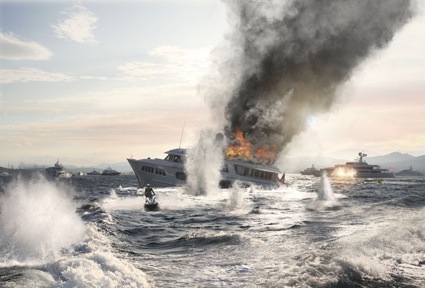 Vincent Debanne, Battleship
Vincent Debanne, Battleship
On his return from Africa in 46 BC, Julius Caesar organised a naumachia, a staged sea battle on a water-filled basin by the river Tiber. For this water extravaganza, ships of two to four banks of oars representing historical fleets were set afloat. On board were thousands of combatants and rowers, prisoners of war or condemned to death who had to fight and reenact famous battles. All for the joy of the Roman people. Caesar’s naumachia was the first documented one. Other, even more grandiose ones would be later organised by emperors in amphitheatres.
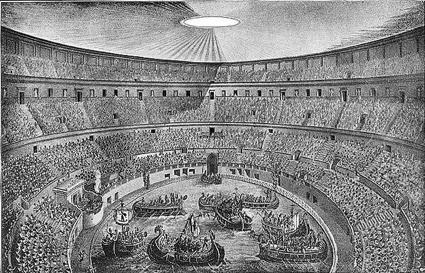 A naumachia held at the Colosseum. Illustration by G. Nispi-Landi, 1913 (image)
A naumachia held at the Colosseum. Illustration by G. Nispi-Landi, 1913 (image)
In his Battleship photo series, Vincent Debanne transposed this kind of flamboyant spectacle to our days of growing wealth inequality.
The artist sets the scene in well-known playgrounds for luxury yachts: the bays of Antibes and of St-Tropez in France. Using image manipulation, Debanne turns these recreational vessels into formidable warships. The photo series also provides a surprisingly realistic commentary on some of our world’s current economic, social and political issues.
I discovered the work of Vincent Debanne at the festival PhotoIreland in Dublin a few weeks ago and i recently contacted him to know more about his work. The artist answered me in french. I translated his text into english but if you scroll down, you’ll find his answers in the original language as well:
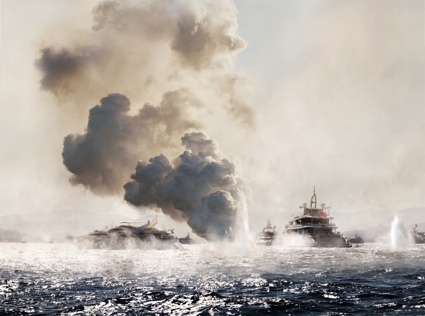 Vincent Debanne, Battleship
Vincent Debanne, Battleship
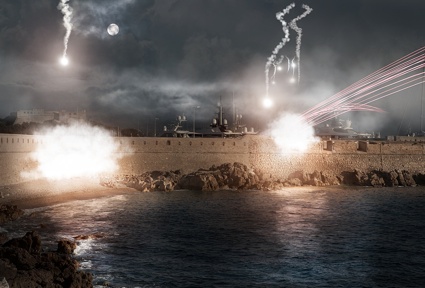 Vincent Debanne, Battleship
Vincent Debanne, Battleship
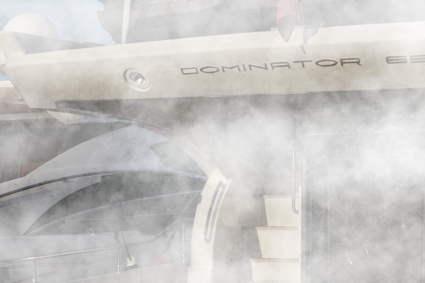 Vincent Debanne, Battleship
Vincent Debanne, Battleship
Hi Vincent! I think what i found most remarkable about the photos (apart from the fact that they are stunning) is that they are completely credible. It took me a while to realize that they were not documenting any actual sea battle. These namachiae look completely logical, that’s what the super rich would do to have fun between two parties, i imagine. But as far as i can understand, all your photo series are based on real social or political concerns. So what did you want to communicate with the series?
With the Battleship series, I want to evoke the display of power performed by the super rich in the exclusive centers of world yachting. The Bay of Saint-Tropez remains an important destination for this activity. I think that this display of luxury is made for two audiences: for the poor, as a show, a triumph, as they would have called it in Rome, but mostly for the rich themselves, the game is one that will require the biggest yacht, the longest length to affirm your status, communicate your high rank to other rich people.
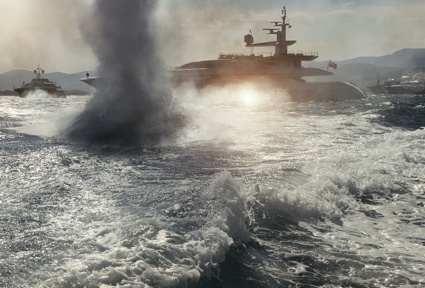 Vincent Debanne, Battleship
Vincent Debanne, Battleship
What does the use of photomontage allow you to express that could not be conveyed through pure documentation or scene setting?
I show this gathering of yachts as a naval battle, because that’s what it is, a balance of power, a fight. Photomontage gives me the opportunity to reveal, to exaggerate this underlying violence, the violence of economic war. These boats, with their aggressive design, their evocative names (unless they have female names), each of them bearing the flag of offshore havens, are already very impressive, but the photomontage makes their warrior appearance even more obvious, and emphasizes their kinship with the military. Furthermore, the world’s largest yacht builder, which is German, also manufactures warships. Some of these yachts are armed with defense systems to fight against piracy. Photomontage makes it all visible!
What was the creative process for Battleship? What did you start with? just a few yacht meeting on the surface of the sea and then you add some explosion effect? How do you construct the photos from there?
The series is done in three stages. First, the shots of yachts on the water and then the photographs of the rear of the yachts moored in the port of Saint-Tropez and Antibes, in order to collect warriors names (a very short type), an image of the port of Antibes (a fortified harbor that shelters the largest yachts in the world), and finally the post-production, special effects, additions of explosions, smoke, etc.
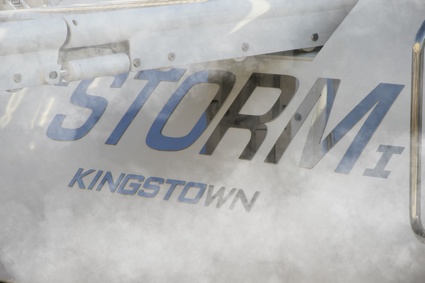 Vincent Debanne, Battleship
Vincent Debanne, Battleship
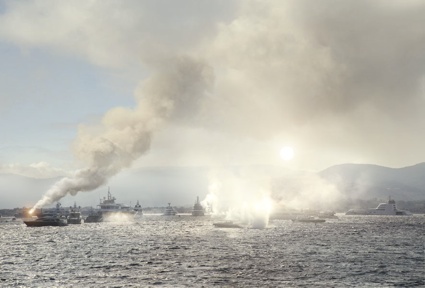 Vincent Debanne, Battleship
Vincent Debanne, Battleship
The scenes in many of your photo series appear uncannily real, but have there’s something about them that makes us question reality itself. Is this something you are conscious of? And how do you manage that?
Yes, my photo series always play with realism: the documentary side of my images is essential. It has to be plausible at first sight. That’s because my work is not fanciful but seeks to interrogate reality, often in a sociological and political perspective. It engages in a dialectical relationship with reality.
Some of your photos series are inspired by paintings. this seems to be the case with Battleship as well. Is it painting in general that inspired you or were you trying to evoke the style of a particular painter or genre?
I like to rely on painting. Rather than a painter in particular, it’s the genre that interests me, with the archetypes it comprehends. These archetypal images help me show archaisms that are still very active nowadays. I proceed by exaggeration and the pastiche is one of its components. It is true that the marine is a theme that is seldom approached in photography, the major example of it remains Gustave Le Gray.
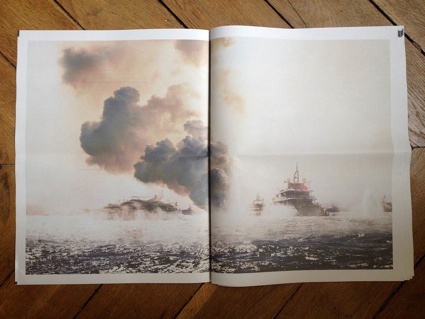 Battleship Journal. Design by Lucie Lecomte and Vincent Debanne
Battleship Journal. Design by Lucie Lecomte and Vincent Debanne
Why did you chose to edit the photos in a journal? instead of a book for example?
I chose the form of a self-published newspaper, remembering how newspapers from the XIXth century used printmaking to relate naval battles. With designer Lucie Lecomte, we chose to leave more room for the image, with double-pages and the journal format that opens up flat. The newspaper remains an effective and inexpensive political medium. It can be distributed!
Thanks Vincent!
French version of Vincent Debanne’s answers:
I think what i found most remarkable about the photos (apart from the fact that they are stunning) is that they are completely credible. It took me a while to realize that they were not documenting any actual sea battle. These namachiae look completely logical, that’s what the super rich would do to have fun between two parties, i imagine. But as far as i can understand, all your photo series are based on real social or political concerns. So what did you want to communicate with the series?
Avec la série Battleship, je veux évoquer la démonstration de force donnée par les très riches dans les lieux privilégiés du yachting mondial. La baie de Saint-Tropez reste une destination importante pour cette activité. Pour moi cet étalage de luxe est effectué pour deux publics : pour les pauvres, comme un spectacle, un triomphe, on aurait dit à Rome, mais surtout pour les riches eux-mêmes, le jeu est à celui qui s’imposera par le plus gros yacht, le plus long métrage, pour affirmer son statut, communiquer son rang aux autres riches.
What does the use of photomontage allow you to express that could not be conveyed through pure documentation or scene setting?
Je montre ce rassemblement de yachts comme une bataille navale, car c’est ce qu’il est, un rapport de forces, un combat. Le photomontage me donne la possibilité de révéler, d’exagérer cette violence sous-jacente, celle de la guerre économique. Ces bateaux, avec leur design agressif, leurs noms si évocateurs (quand il ne s’agit pas de noms de femmes), tous sous des pavillons de paradis Offshore, sont déjà très impressionnants, mais le photomontage rend leur aspect guerrier plus évident, et souligne leur parenté avec le militaire. D’ailleurs le plus grand constructeur mondial de yacht, qui est allemand, fabrique également des navires de guerre. Et certains de ces yachts sont armés de systèmes de défense, pour lutter contre la piraterie. Le photomontage fait que tout cela devient visible !
What was the creative process for Battleship? What did you start with? just a few yacht meeting on the surface of the sea and then you add some explosion effect? How do you construct the photos from there?
La série est réalisée en trois temps, d’abord les prises de vues des yachts sur la mer, puis des photographies de l’arrière des yachts amarrés au port de Saint-Tropez et d’Antibes, pour collecter des noms guerriers (une très courte typologie), une image du port d’Antibes (port fortifié abritant les plus grands yachts du monde), et enfin la post-production, les effets spéciaux, additions d’explosions, fumées etc.
The scenes in many of your photo series appear uncannily real, but have there’s something about them that makes us question reality itself. Is this something you are conscious of? And how do you manage that?
Oui, il y a toujours un jeu dans mes séries photographiques avec le réalisme : la part documentaire de mes images est essentielle. Il faut que cela soit plausible au premier abord. Car mon travail n’est pas fantaisiste mais cherche à questionner la réalité, souvent sous un angle sociologique et politique. Il engage un rapport dialectique avec le réel.
Some of your photos series are inspired by paintings. this seems to be the case with Battleship as well. Is it painting in general that inspired you or were you trying to evoke the style of a particular painter or genre?
J’aime m’appuyer sur la peinture : plus qu’un peintre en particulier, c’est effectivement le genre qui m’intéresse avec les archétypes qu’il comporte. Ces images archétypales me sont utiles pour montrer les archaïsmes encore très actifs dans notre époque contemporaine. Je procède par exagération et le pastiche en est une des composantes. Il est vrai que les marines sont un thème peu traité en photographie, l’exemple majeur restant Gustave Le Gray.
Why did you chose to edit the photos in a journal? instead of a book for example?
J’ai choisi la forme du journal, autoédité, en me rappelant les journaux du XIX eme siècle qui relataient les batailles navales en gravure. Avec la graphiste Lucie Lecomte, nous avons choisi de laisser la plus grande place à l’image, sur des doubles pages et le format du journal permet d’ouvrir bien à plat. Le journal reste un médium politique efficace et peu cher. Il peut être distribué !!!
Merci Vincent!
Also at the festival Photo Ireland: Anecdotal radiations, the stories surrounding nuclear armament and testing programs.
